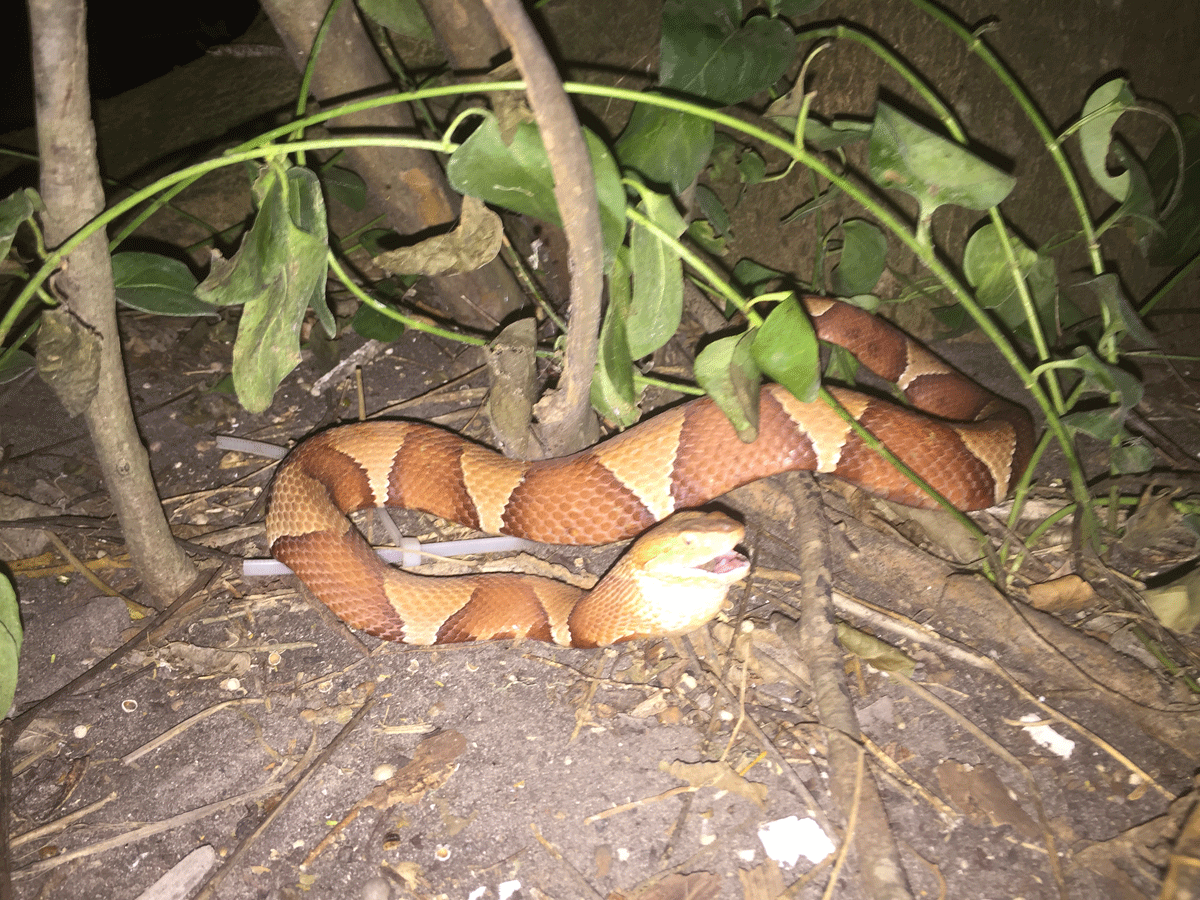Photo: Creepy Copper, the copperhead snake, swallowing a leopard frog while coiled up at the base of a hackberry tree.
For the past few weeks, a copperhead (Agkistrodon contortrix laticinctus), has been coiling up in the late afternoon under a sugar hackberry tree (Celtis laevigata) that grows a few feet from our back porch and beside the path to the trampoline. The five oldest of our seven grand-brats, Halley, Stella, Hannah, Sam, and Oliver, are very aware there are copperheads in our yard. They know how to recognize them and how to avoid them. They have dubbed this particular copperhead “Creepy Copper.”
Creepy Copper is usually at the base of the hackberry tree in preparation for cruising around to catch and eat June bugs and cicadas. This particular evening, according to Halley and Hannah, he got lucky and nabbed a leopard frog (Rana utricularia). By the time Carl, their father, took the photo the frog was almost swallowed and couldn’t be positively identified, but the girls are budding zoologists and I trust their identification.
How do I know Creepy Copper is the same snake each evening? Simple each copperhead has a unique pattern of blotching. Additionally, this snake has unusual scaling. The scales are raised a bit, making him look beaded. Why do I use the masculine pronoun; well, based on its shape, I think it is a male.
Copperheads like our yard because we water. June bugs and cicadas show their appreciation for the plentiful water by being very common. During June and July both species’ nymphs emerge from the ground about dusk to around 10:00 PM to eclose as winged adults. Our copperheads start coming out of their hiding places about an hour before dark, coiling up and waiting for dinner. At dark they begin slowly cruising, searching for the emerging nymphs. According to one study cicadas and June bugs make up 80% of their diets in June and July. The rest of the year copperheads feed on a variety of foods, including mice, frogs, insects, lizards, and the like.
For more information about our copperheads see the following blogs:
http://goliadfarms.com/copperhead-in-tree/
http://goliadfarms.com/mayas-copperhead-bite/
http://goliadfarms.com/mayas-copperhead-bite-update/
http://goliadfarms.com/copperhead-hunting-a-cicada/
http://goliadfarms.com/copperhead-eating-a-cicada/
http://goliadfarms.com/copperhead-bites-sadie/
http://goliadfarms.com/copperhead-eating-lizard/
Before ending let me respond to what I imagine many people think about copperheads and other poisonous snakes. Most people think the only good snake is a dead snake. I don’t for many reasons. One is an ethical issue. These snakes were here long before we were. They are only trying to make a living. They don’t bite out of spite, just to protect themselves. Their venoms are expensive to make and are primarily used to kill prey to eat. Using the venom for others purposes such as defense depletes their supply.
Just from a practical point of view, removing by killing or relocation is paradoxically counterproductive. Studies show that resident large pit vipers like copperheads are territorial and one large snake excludes many small snakes. Also, older snakes are less likely to deliver venom in a defensive bite. I’ve experienced this having been given a dry bite by a large copperhead I stepped on once (a reason not to wear Crocs or put your foot where you haven’t looked!). I had fang marks and very slight swelling, but that was it. Contrast that with the bite I received from a young Western Diamondback Rattlesnake (Crotalus atrox). She, yes it was a female, delivered a full dose of venom requiring two days in the hospital.
Next, and most important to Susie, my wife, is that snakes control rodents. We live in a house built by my great grandfather in 1908. It is not airtight. Mice enter at will. Susie despises them and their messes. Usually the worst time for mice in the house is winter when the snakes aren’t active. Unfortunately, the last two years mice have been a problem all the time and I have traps running continuously. Why is this happening? I think it’s a result of a weather pattern we’ve had the last two years. Our annual rainfall has been higher than normal with January through June being especially wet. Our local amphibians have responded to the resulting standing water by breeding almost continuously leading to a frog and toad population explosion. There have been two consequences of this explosion. First, and beneficially, the grasshopper and cricket populations have crashed and our vegetable gardens have thrived. Why has this happened? It’s because the plentiful frogs and toads devour the grasshoppers and crickets. Second, the amphibian population explosion has provided snakes a ready source of food in the form of young of leopard frogs, bullfrogs, tree frogs, and cricket frogs. The snakes seem to have switched to this buffet of amphibians and have ignored mice and rats. This in turn has resulted in an explosion in the numbers of deer mice and woodrats. One environmental change can have many unanticipated results.
By the way, we make use of the trapped mice. Our chickens love them. Yum-yum.


Justin says
Gorgeous broad band! I really love the trans-pecos ssp.
charles says
Justin,
I happen to think our population is the prettiest. What doesn’t show well in photos is the bright green tail tip, which I think they use as a lure for Anolis carolinensis (American chameleon). I do like the Big Bend population as well.
Charles
Dave says
Nice photos of the Copperheads. Curious, you say you leave the snakes alone because they were there before you. So were the mice. Why deny the mice? I have yard snakes in PA and like them because they eat the big field spiders and other bugs and mice. Not because they were here first. I also let the fox and predator birds alone.
Charles Clapsaddle says
Dave, Thank you. We leave mice alone when they stay out of the house. Those in the house are live-trapped and relocated or fed to the chickens. As long as predators leave our livestock alone, we leave them alone. Those that don’t are live-trapped and relocated. Charles